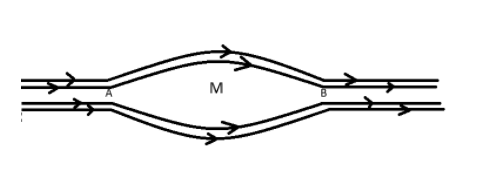
An uncharged particle is moving with a velocity of \[\vec v\] in a non-uniform magnetic field as shown. Velocity $\vec v$ would be

(A) Maximum at $A$ and $B$
(B) Minimum at $A$ and $B$
(C) Maximum at $M$
(D) Same at all points
Answer
217.2k+ views
Hint We are given that the particle is uncharged and also are given with this diagram and we are told that the particle is moving in a magnetic field. Thus, we will take into account the Lorentz force formula which will connect all the given parameters to the required one.
Formula used
${\vec F_L} = q(\vec v \times \vec B)$
Where, ${\vec F_L}$ is the Lorentz force vector, $q$ is the charge on the particle, $\vec v$ is the velocity of the particle and $\vec B$ is the magnetic field in which the particle is moving.
Complete Step By Step Solution
According to Newton’s laws, we know that for a particle to move, there has to be some external force acting on it. Also, we know that for a particle to move in a magnetic field, there has to be a charge on it.
Now,
In this case, the particle is uncharged.
$\therefore q = 0$
Thus from the Lorentz force formula
${\vec F_L} = q(\vec v \times \vec B)$
We can say,
${\vec F_L} = \vec 0$
Thus, there is no Lorentz force acting on the particle at any point in the trajectory.
Also, in accordance to the question, there is no external force acting on the particle.
Thus =, the velocity of the particle $\vec v$ is constant throughout the flow in the given trajectory.
Thus, the answer is (D).
Note The question was about the change in velocity vector of the particle in the three points which we found was the same throughout. But if the question was about the magnetic field change, then the answer would not be the same.
Formula used
${\vec F_L} = q(\vec v \times \vec B)$
Where, ${\vec F_L}$ is the Lorentz force vector, $q$ is the charge on the particle, $\vec v$ is the velocity of the particle and $\vec B$ is the magnetic field in which the particle is moving.
Complete Step By Step Solution
According to Newton’s laws, we know that for a particle to move, there has to be some external force acting on it. Also, we know that for a particle to move in a magnetic field, there has to be a charge on it.
Now,
In this case, the particle is uncharged.
$\therefore q = 0$
Thus from the Lorentz force formula
${\vec F_L} = q(\vec v \times \vec B)$
We can say,
${\vec F_L} = \vec 0$
Thus, there is no Lorentz force acting on the particle at any point in the trajectory.
Also, in accordance to the question, there is no external force acting on the particle.
Thus =, the velocity of the particle $\vec v$ is constant throughout the flow in the given trajectory.
Thus, the answer is (D).
Note The question was about the change in velocity vector of the particle in the three points which we found was the same throughout. But if the question was about the magnetic field change, then the answer would not be the same.
Recently Updated Pages
Introduction to Dimensions: Understanding the Basics

[Awaiting the three content sources: Ask AI Response, Competitor 1 Content, and Competitor 2 Content. Please provide those to continue with the analysis and optimization.]

Wheatstone Bridge Explained: Working, Formula & Uses

Young’s Double Slit Experiment Derivation Explained

JEE Atomic Structure and Chemical Bonding important Concepts and Tips

JEE Amino Acids and Peptides Important Concepts and Tips for Exam Preparation

Trending doubts
JEE Main 2026: Application Form Open, Exam Dates, Syllabus, Eligibility & Question Papers

Derivation of Equation of Trajectory Explained for Students

Hybridisation in Chemistry – Concept, Types & Applications

Understanding the Angle of Deviation in a Prism

Understanding Collisions: Types and Examples for Students

How to Convert a Galvanometer into an Ammeter or Voltmeter

Other Pages
JEE Advanced Marks vs Ranks 2025: Understanding Category-wise Qualifying Marks and Previous Year Cut-offs

Understanding Atomic Structure for Beginners

Ideal and Non-Ideal Solutions Explained for Class 12 Chemistry

Degree of Dissociation: Meaning, Formula, Calculation & Uses

Understanding Electromagnetic Waves and Their Importance

Understanding the Electric Field of a Uniformly Charged Ring




